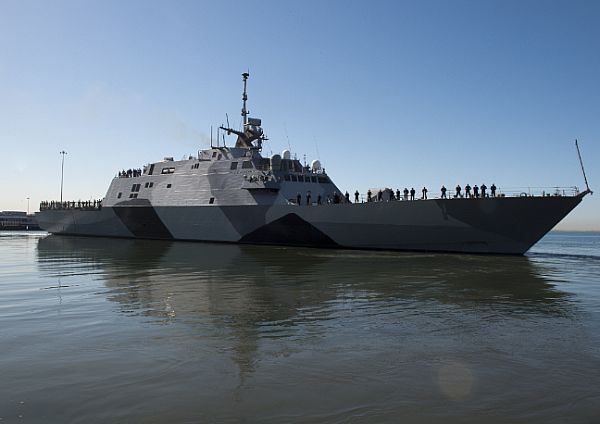Iranian Ship Linked to Houthi Attacks Heads Home Amid Tensions
(Bloomberg) — An Iranian ship that’s been linked to Houthi attacks in the Red Sea is returning home, removing a prominent asset in the area as the Islamic Republic braces...


The littoral combat ship USS Freedom (LCS 1) as it departs San Diego Bay for a deployment to the Asia-Pacific region, on March 1, 2013. (U.S. Navy photo)
By David Lerman
July 25 (Bloomberg) — Lawmakers said today they have “serious questions” about the Navy’s Littoral Combat Ship after a Government Accountability Office report recommended slowing construction for further testing.
While there was no indication that the Navy’s newest warship was in immediate jeopardy, members of the House Armed Services seapower subcommittee said the small, speedy and adaptable ship needs increased scrutiny in light of warnings about its unproven technology.
“Nine years into the program, many of us on this subcommittee and many of our colleagues in the House have serious questions regarding the LCS’s concept of operations, its maintenance and sustainment concept and its survivability in a combat environment,” said Representative Joe Courtney, a Connecticut Democrat.
After having agreed to fund ship construction without completion of testing, “we find a program facing cost growth, schedule delays and problems meeting intended capabilities,” Courtney said.
A report by the GAO, Congress’s nonpartisan investigative arm, found the Navy is risking as much as $40 billion by purchasing the ships faster than it can demonstrate their “militarily useful capability.”
The LCS program has generated a growing list of questions about the ships’ designs, firepower, defenses and survivability at a time when the Pentagon faces as much as $500 billion in additional budget cuts over the next nine years.
Buy, Fly
“The strategy has been ‘Buy before fly,’” said Paul Francis, the GAO’s managing director of acquisition and sourcing management, who testified at today’s hearing. “It is a ship in full-rate production, but its operational effectiveness will not be demonstrated for years to come. That’s where we are today.”
Most of the planned 52 ships will already be under contract or built by the time operational testing is completed in 2019, he said.
“I am troubled by the fact that we are purchasing first and testing second,” said Representative Jackie Speier, a California Democrat. “I feel that there’s this rush to construction and we’ll worry about the details later.”
The Navy is buying two versions of the ship. One, with a traditional steel hull, is being made in Marinette, Wisconsin, by a group led by Lockheed Martin Corp., based in Bethesda, Maryland. The second version is an aluminum trimaran, or three- hulled vessel, built by a group led by Austal Ltd., based in Henderson, Australia.
‘Minimum Quantities’
Francis said the Navy should consider buying the ship only in “minimum quantities” until enough testing is completed to prove its effectiveness.
Sean Stackley, the Navy’s assistant secretary for research, development and acquisition, rejected the GAO’s advice, saying any pause in construction would increase costs and delay needed testing.
“Now is not the time to slow the program,” Stackley told the panel. “This is our most affordable warship program.”
Construction costs have doubled to an average of $440 million per ship from an original goal of $220 million, the Navy has said.
A confidential 2012 Navy study found the ships are too lightly armed, that plans to swap equipment for different missions are impractical, and the decision to build two different versions of the ship simultaneously complicates logistics and maintenance.
‘Critical Flaws’
“The LCS program was initiated with critical flaws,” Stackley said. “We are all well aware of that.”
Now that the program has been revamped, he said, “our costs are under control and greatly improved and contained in fixed-price contracts.”
Even as they raise questions, lawmakers voted yesterday to let construction proceed on schedule. The House passed a defense spending bill that includes the Navy’s requested funding for four more Littoral Combat Ships in the fiscal year that begins Oct. 1.
“Criticism of the LCS program is warranted,” said Representative Randy Forbes, a Virginia Republican who is chairman of the seapower panel. “But let me emphasize that none of these reports disputes the necessity to rapidly field the capabilities proposed by the Littoral Combat Ship.”
The GAO’s report represents the latest red flag that’s been raised inside and outside the Navy about the small and speedy ship designed for shallow waters close to shore, such as in the Persian Gulf.
A confidential Navy report completed last year warned the ships may not be able to perform their missions because they’re too lightly manned and armed.
Lost Propulsion
The first Littoral Combat Ship to deploy overseas, the USS Freedom, lost propulsion on July 20 while heading to a military exercise and had to return to port in Singapore for repairs. The Navy determined the ship’s diesel generators overheated and shut down, said Lieutenant Caroline Hutcheson, a Navy spokeswoman.
After repairs that included the replacement of turbochargers in the generators and clogged fuel injectors, the Freedom got under way yesterday, she said.
The ship is designed to be adaptable by using interchangeable modules for various missions, such as clearing mines, hunting submarines and waging surface warfare.
Copyright 2013 Bloomberg.
Join the gCaptain Club for curated content, insider opinions, and vibrant community discussions.


Join the 105,979 members that receive our newsletter.
Have a news tip? Let us know.
Access exclusive insights, engage in vibrant discussions, and gain perspectives from our CEO.
Sign Up




Maritime and offshore news trusted by our 105,979 members delivered daily straight to your inbox.



Essential news coupled with the finest maritime content sourced from across the globe.
Sign Up